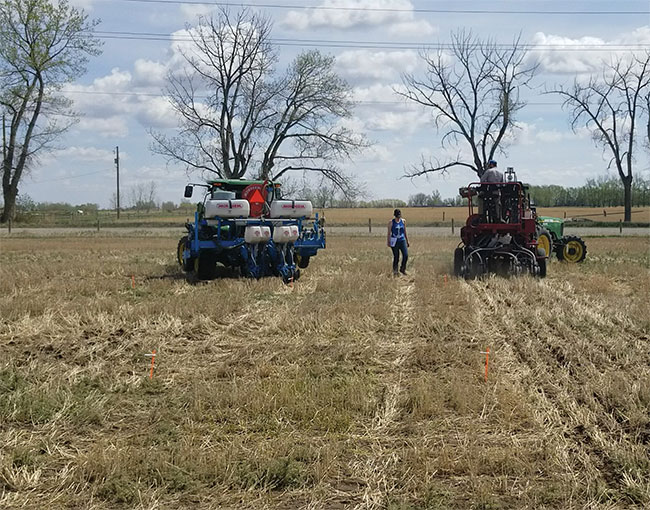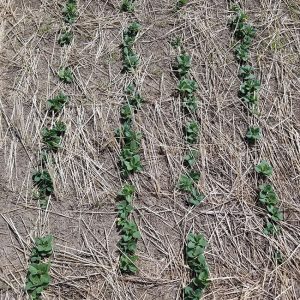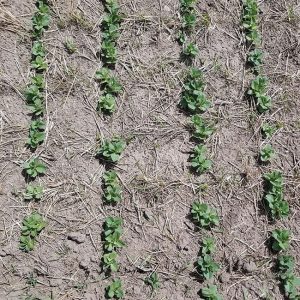
Features
Agronomy
Seeding/Planting
Are there benefits to precision planting pulses?
A four-year study seeks answers.
February 11, 2022 By Bruce Barker
 Large-seeded pulses like chickpeas, field peas and faba beans established better with a precision planter.
Large-seeded pulses like chickpeas, field peas and faba beans established better with a precision planter. Seeding corn with surgical precision is a common practice for growers, and some canola growers are also adopting the use of planters over air drills. A four-year research trial in southern Alberta by Farming Smarter is looking into whether planters could provide a benefit in pulse crops as well.
“Growers are adopting precision planters, especially for
canola seed production, in addition to the row crops. However, planters are expensive,” says Gurbir Dhillon, research scientist with Farming Smarter in Lethbridge, Alta. “If planters can be adopted for a broader range of crops, that could justify the initial equipment cost better. Especially if there is an advantage to using precision planters for other small-seeded crops like pulses, durum, and hemp.”
Farming Smarter initiated at four-year study from 2019 through 2022 in Lethbridge, Medicine Hat and Taber, Alta., for a total of 12 site-years. The objective was to see if planters could be adopted as an all-encompassing seeding tool to help improve crop establishment, reduce crop inputs, and create opportunity to grow novel new crops in southern Alberta. Pulse crops in the study included chickpea, lentil, faba bean, soybean, and field peas.
A Monosem planter was compared to an air drill. The air drill used Pillar laser disc-hoe openers on 12-inch row spacing. The Monosem planter was also set up on 12-inch row spacing with disc openers. Seeding depth was two inches.
Pea, lentil and chickpea were seeded at two different rates of 10 seeds per square foot (100 seeds/m2) or five seeds per square foot (50 seeds/m2). Soybean, faba bean and chickpea were seeded at five seeds per square foot (50 seeds/m2) or 2.5 seeds per square foot (25 seeds/m2). The higher seeding rate for each crop was considered to be the normal seeding rate, while the lower seeding rate was considered to be 50 per cent of normal. The cut-rate was included because some canola growers have realized cost savings with planters by cutting back on the seeding rate without any yield penalties.
With two years of preliminary data, and 2021 results still under analysis, some trends have emerged.
- Side-by-side comparisons of plant stands of faba bean seeded with an air drill [left] compared to a planter [right]. Photos courtesy of Farming Smarter.
Better emergence and stand establishment
Dhillon says that the first two years of data showed that precision planting improved the seedling emergence of chickpeas, faba beans and field peas. Stand uniformity and staging were also improved with precision planting compared to the air drill. Lentil and soybean results were more variable.
“Precision planters can reduce inter-plant competition due to uniform spacing, which may help with emergence. They also provide superior depth control, which may have helped with moisture availability in some dry years,” Dhillon says.
Chickpea and field pea canopy closure was also faster with the planter, although only one year of data has been analyzed for this trait.
Looking at yield, there were some advantages to the planter, but just as important, yield for precision planters was similar or higher than the air drill. Put another way, none of the site-years showed a statistically significant yield-penalty to precision planting.
“We also observed a yield advantage for precision planted pulses for some site years – chickpeas (three out of six), faba beans (two of six) and field peas (two of six),” Dhillon says.
No advantage to cutting seeding rate
Unlike precision planted canola, Dhillon did not see any advantage when cutting the seeding rate by one-half.
“We might do another study in the future that looks at a wider range of seeding rates to determine the optimal seeding rate with planters for some of these pulse crops,” Dhillon says. “In the
absence of reduction in seeding rates, the advantages to precision planting are in better emergence, uniform crop establishment and staging, and higher yields in certain environments. Better staging can also help with pesticide or plant growth regulator application timings.”
While the research results are yet to be finalized, based on preliminary observations, Dhillon says that large seeded pulses like chickpeas, field peas, faba beans seemed to do better with precision planters. Lentils did not show a huge advantage to precision planting which may be linked with smaller seed size and cylindrical seed shape.

